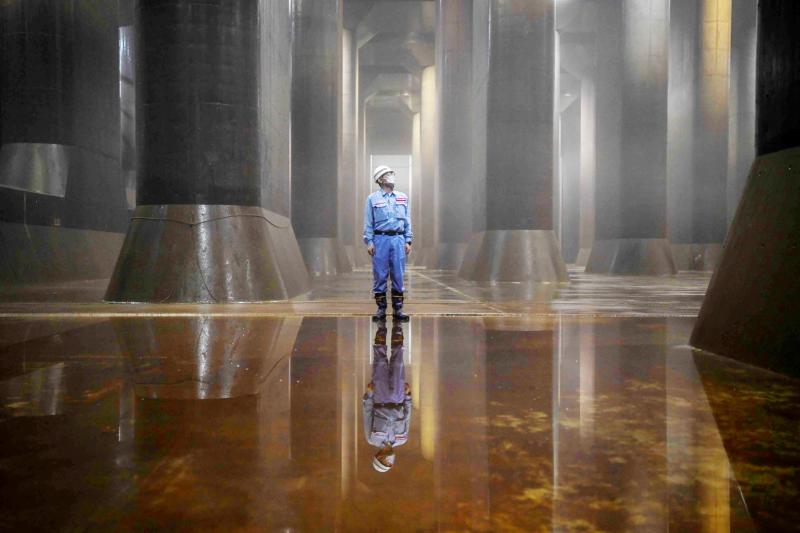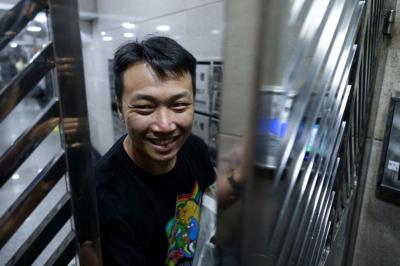It has been called Japan’s underground “Parthenon,” a cavernous complex charged with protecting Tokyo and surrounding areas from catastrophic flooding — a risk experts say is growing as climate change advances.
Above ground, there is little to give away the cathedral-like feat of engineering that forms the main reservoir of the Kasukabe flood tank, the largest facility of its kind in the world.
The immense structure — deep enough in some parts to hold the Statue of Liberty — funnels away and redirects excess water from storms and typhoons, protecting one of the globe’s most populous capitals.

Photo: AFP
Soaring pillars weighing 500 tonnes support the main reservoir, a bare concrete tank the length of two soccer pitches.
Staff at the facility in Saitama, north of Tokyo, are on constant alert, especially during Japan’s rainy and typhoon seasons from June to October.
“In this area, torrential rain, typhoons and even daily rainfall can cause damage by submerging houses and roads,” said the site’s head, Nobuyuki Akiyama.
The reservoir has helped reduce the number of homes affected by water damage in nearby areas by about 90 percent, he said.
In Tokyo alone — a city cut through by more than 100 rivers — there are 10 other underground reservoirs and three flood tunnels, and more flood-protection structures are being built.
In Osaka, a flood facility similar to the Kasukabe reservoir is being built at a cost of ¥366 billion (US$3.5 billion). Construction is scheduled to finish in 2044.
However, experts say that more could be needed, as climate change makes what were previously once-in-a-century storms increasingly common, and catastrophic.
“Japan ... has a climate in which floods and heavy rain tend to occur frequently, but on top of that, now global warming is advancing,” said Kei Yoshimura, professor of meteorology at the University of Tokyo and an expert on flooding.
Massive flooding and landslides in July killed more than 80 people in western Japan, while a typhoon last year killed nearly 100 people in the east.
The Japan Meteorological Agency says that the number of typhoons a year that threaten Tokyo has jumped 1.5 times in the past four decades.
The Kasukabe reservoir is connected to a 6.3km tunnel and the system can release accumulated water into the nearby Edogawa River at a rate equivalent to discharging a 25m swimming pool every second, with the power of a jet engine.
Built in 2006, at a cost of ¥230 billion, the facility is used about seven times a year.
Excess water flows in automatically and operators pump it out from the main tank when it approaches capacity, Akiyama said.
This year it had already been used seven times by last month, with water discharged twice after an unusually long rainy season, he said.
Official studies credit the single facility with having saved ¥148 billion in cleanup costs so far.
Japan’s anti-flood systems are considered world class, with the nation having learned bitter lessons from several major disasters after World War II, but experts, including Yoshimura, say that infrastructure alone is not enough, especially with advancing climate change, and Japanese authorities have stepped up efforts to remind people to evacuate their homes early when requested.
The Kasukabe system accepts visitors when it is not in use, in part to promote the importance of disaster management.
“This underground facility is great, but it’s only one defense measure,” said Toru Tamai, a 79-year-old who attended a tour. “I live on low ground, so floods are a clearer and more present danger than any other natural disasters. In the end, you can’t count on anyone but yourself.”

Four people jailed in the landmark Hong Kong national security trial of "47 democrats" accused of conspiracy to commit subversion were freed today after more than four years behind bars, the second group to be released in a month. Among those freed was long-time political and LGBTQ activist Jimmy Sham (岑子杰), who also led one of Hong Kong’s largest pro-democracy groups, the Civil Human Rights Front, which disbanded in 2021. "Let me spend some time with my family," Sham said after arriving at his home in the Kowloon district of Jordan. "I don’t know how to plan ahead because, to me, it feels

Polish presidential candidates offered different visions of Poland and its relations with Ukraine in a televised debate ahead of next week’s run-off, which remains on a knife-edge. During a head-to-head debate lasting two hours, centrist Warsaw Mayor Rafal Trzaskowski, from Polish Prime Minister Donald Tusk’s governing pro-European coalition, faced the Eurosceptic historian Karol Nawrocki, backed by the right-wing populist Law and Justice party (PiS). The two candidates, who qualified for the second round after coming in the top two places in the first vote on Sunday last week, clashed over Poland’s relations with Ukraine, EU policy and the track records of their

‘A THREAT’: Guyanese President Irfan Ali called on Venezuela to follow international court rulings over the region, whose border Guyana says was ratified back in 1899 Misael Zapara said he would vote in Venezuela’s first elections yesterday for the territory of Essequibo, despite living more than 100km away from the oil-rich Guyana-administered region. Both countries lay claim to Essequibo, which makes up two-thirds of Guyana’s territory and is home to 125,000 of its 800,000 citizens. Guyana has administered the region for decades. The centuries-old dispute has intensified since ExxonMobil discovered massive offshore oil deposits a decade ago, giving Guyana the largest crude oil reserves per capita in the world. Venezuela would elect a governor, eight National Assembly deputies and regional councilors in a newly created constituency for the 160,000

North Korea has detained another official over last week’s failed launch of a warship, which damaged the naval destroyer, state media reported yesterday. Pyongyang announced “a serious accident” at Wednesday last week’s launch ceremony, which crushed sections of the bottom of the new destroyer. North Korean leader Kim Jong-un called the mishap a “criminal act caused by absolute carelessness.” Ri Hyong-son, vice department director of the Munitions Industry Department of the Party Central Committee, was summoned and detained on Sunday, the Korean Central News Agency (KCNA) reported. He was “greatly responsible for the occurrence of the serious accident,” it said. Ri is the fourth person